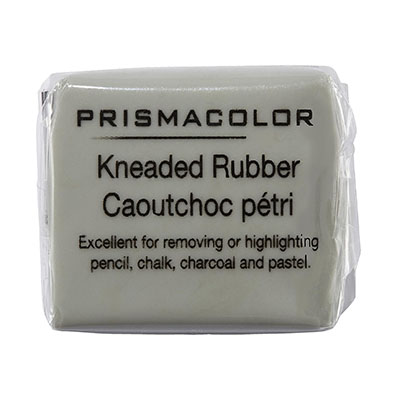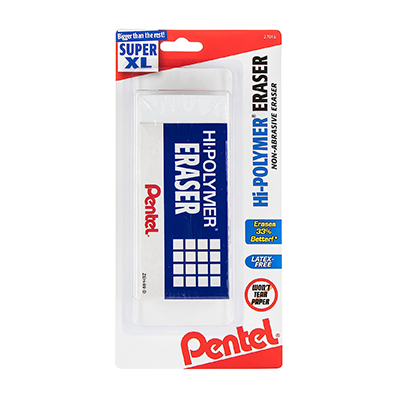The best erasers
We've picked the best erasers for both pencil and pen. Pen is especially important because it can be quite hard to erase.

The best erasers, or rubbers, are extremely important for many creatives. Often, they're used to remove mistakes but for artists, they have extra uses as they can also be used to create highlights and special effects. You can use an electric eraser for this purpose, though a kneaded eraser will likely do the trick, especially as they can be shaped into a precise form.
The major types of erasers are gum erasers, these are best for delicate papers; kneaded erasers, which are best for erasing large spaces and creating highlights; eraser pencils – meant for removing fine details; vinyl erasers for removing ink marks; and rubber erasers, which are most often found on the tops of pencils.
For this guide, we've scoured the internet and picked a range of the best erasers based on user reviews, as well as our knowledge of the type of erasers artists need. If you're stocking up your pencil case, you may also like our posts on the best pencil sharpeners and the best coloured pencils.
The best erasers available now
Why you can trust Creative Bloq

Best overall
Type: kneaded
Quality: professional
This kneaded eraser works really well – just stick it on the area with the graphite and lift. It also works well for coloured pencils and charcoal marks. You can easily change the size of it and it's great for small details. The only downside is it absorbs graphite and charcoal, so you will run out of clean surfaces, quickly.

Most versatile
Type: kneaded
Quality: professional
This eraser is great at rubbing out various materials, including chalk, charcoal, pastels and coloured pencils. You can easily mould it to the size and shape of whatever you need to erase. Maintenance is simple too as to clean it, you just knead it gently with your hands.

Best for students
Type: soft rubber
Quality: student
The eraser is 100% latex-free and smudge-resistant. It’s perfect for exams, essays, and ordinary writing. The flat faces and sharp corners are meant for details and sharp edges and this eraser is for students and artists. This package comes with 12 erasers.

Best electric eraser
Type: electric
Quality: professional
This battery-operated eraser includes 8 tips and required 2 AAA batteries, which are not included. The erasers are long-lasting and easy to remove. The eraser offers precision and speed. It's best for small areas. Note: Watch the instructional video to get the best out of this product.

Best soft eraser
Type: soft eraser
Quality: professional
If you prefer a block shape, this eraser will do the trick. It does a great job of erasing with minimal pressure and removes graphite with low smearing. It's great for sketches and small details. Since there's no sleeve, it will get dirty over time, but that has no effect on the quality of the erasing.

Best mechanical eraser
Type: mechanical
Quality: professional
This is one of my favourite types of eraser, because it can be held like a pen/pencil and used for erasing. The eraser is latex-free and is a great gift. As a mechanical eraser it's easy to use and efficient. A must have in any serious artist's toolbox.

Best hard eraser
Type: hard PVC
Quality: professional
This is a high-quality eraser, which erases well with minimum pressure. Not only that, it's hard to break, easy to hold and the residual shavings tend to clump together, making cleanup a breeze. Small bumps on this rubber show you the ideal gripping point.

Best for ease
Type: soft eraser
Quality: professional
This eraser is latex-free and removes lead easily with little pressure. A few passes is all it takes. The block shape allows you to erase large areas quickly. It is low on smudging and paper tears and it doesn't harden with age, remaining nice and soft.

Best for pen
Type: medium firmness
Quality: professional
A major benefit (and drawback) of ink is its permanence. Fortunately, there are erasers that will remove pen marks. This Staedtler eraser is made for erasing graphite on paper and matte drafting film and it works really well with minimal residue.
When were erasers invented?
Erasers, also known as rubbers, have been used in many forms for hundreds of years. In the past, people used bread, bits of rubber, wax, or even stone.
In 1770, a natural plant rubber was discovered by Edward Nairne, an English engineer. One day, when he picked up a piece of rubber, he discovered it could erase pencil markings. He started selling erasers, (known as gum elastic or 'caoutchouc'). Unfortunately, these early erasers didn't last well. They crumbled when used, they were too sensitive to weather conditions and often picked up an unpleasant smell.
In 1839, inventor Charles Goodyear found the solution, a process he called 'vulcanization'. This made rubber more durable and made the eraser into a household name.
Based on his invention, we now have erasers of different types and shapes, each one meant to serve a particular purpose.
Daily design news, reviews, how-tos and more, as picked by the editors.
Nathan has been working as a writer for the past 25 years, In that time, he's been published over 1,000 times in magazines all over the world and he's written twelve books. His greatest success was the Corel PHOTO-PAINT X4 Insider, which sold over 11,000 copies. He is currently working on licensing his works and there are several in process.

